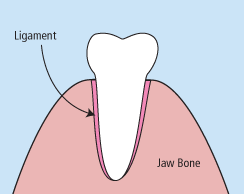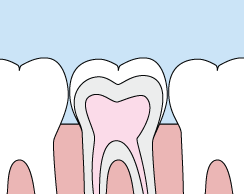Common Procedures
Topics on this page

Regular Exams and Cleanings
Regular exams are an important part of maintaining your child's oral health. During your child's regular exam, we will:
- Check for any problems that may not be seen or felt
- Look for cavities or any other signs of tooth decay
- Inspect the teeth and gums for gingivitis and signs of periodontal disease
- Perform a thorough teeth cleaning
Each regular exam includes a detailed teeth cleaning, in which we will clean, polish, and rinse the teeth to remove any tartar and plaque that have built up on the tooth's surface.
Visiting our office every six months gives you the chance to talk to the doctor about any questions you may have about your child's oral health. Regular exams are offered by appointment only, so please contact our practice today to schedule your child's next dental exam and teeth cleaning.
Bonding
 Bonding is a conservative way to repair slightly chipped, discolored, or crooked teeth. During dental bonding, a white filling is placed onto your child's tooth to improve its appearance. The filling “bonds” with the tooth, and because it comes in a variety of tooth-colored shades, it closely matches the appearance of your child's natural teeth.
Bonding is a conservative way to repair slightly chipped, discolored, or crooked teeth. During dental bonding, a white filling is placed onto your child's tooth to improve its appearance. The filling “bonds” with the tooth, and because it comes in a variety of tooth-colored shades, it closely matches the appearance of your child's natural teeth.
Tooth bonding can also be used for fillings instead of amalgam. Many patients prefer bonded fillings because the white color is much less noticeable than silver. Bonding fillings can be used on front or back teeth, depending on the location and extent of tooth decay.
Bonding is less expensive than other cosmetic treatments and can usually be completed in one visit to our office. However, bonding can stain and is easier to break than other cosmetic treatments, such as porcelain veneers. If it does break or chip, tell your doctor. The bonding can generally be easily patched or repaired in one visit.
Crowns For Children
 Sometimes there is decay on a "Baby" tooth that has been there for a long time and it can destroy a significant amount of the tooth structure. When this happens a filling is not the best choice to restore the tooth. For these cases we have preformed stainless steel crowns specially designed by 3M for "baby" teeth. We also have All-ceramic crowns for the molars as well, by EZ PEDO
Sometimes there is decay on a "Baby" tooth that has been there for a long time and it can destroy a significant amount of the tooth structure. When this happens a filling is not the best choice to restore the tooth. For these cases we have preformed stainless steel crowns specially designed by 3M for "baby" teeth. We also have All-ceramic crowns for the molars as well, by EZ PEDO
Stainless steel crowns have been proven to be a very succesful restoration for large cavities on primary teeth. They will last as long as the primary tooth would have lasted and their failure rate is very low.
If an anterior primary tooth needs a crown, we do have esthetic alternatives. We use the EZ PEDO Zirconia Crowns, for those patients that have concerns about the social and psychological impact of the "stainless steel smile". We have them for the front and back teeth.
Click here to see Before and After resulfts of EZ PEDO Zirconia Crowns.
Extractions
 There are times when it is necessary to remove a tooth. Sometimes a baby tooth has misshapen or long roots that prevent it from falling out as it should, and the tooth must be removed to make way for the permanent tooth to erupt. At other times, a tooth may have so much decay that it puts the surrounding teeth at risk of decay, so the doctor may recommend its removal. Infection, orthodontic correction, or problems with a wisdom tooth can also require removal of a tooth.
There are times when it is necessary to remove a tooth. Sometimes a baby tooth has misshapen or long roots that prevent it from falling out as it should, and the tooth must be removed to make way for the permanent tooth to erupt. At other times, a tooth may have so much decay that it puts the surrounding teeth at risk of decay, so the doctor may recommend its removal. Infection, orthodontic correction, or problems with a wisdom tooth can also require removal of a tooth.
When it is determined that a tooth needs to be removed, Dr. Vega may extract the tooth during a regular checkup or may request another visit for this procedure. The root of each tooth is encased within the jawbone in a “tooth socket”, and the tooth is held in that socket by a ligament. In order to extract a tooth, the dentist must expand the socket and separate the tooth from the ligament holding it in place. While this procedure is typically very quick, it is important to share with the doctor any concerns or preferences for sedation.
Sometimes a primary tooth is lost before the permanent tooth beneath it is ready to erupt. The most common causes for this are cavities and injuries. If your child loses a tooth prematurely we may recommend a space maintainer. A space maintainer is an appliance that holds open the space left by the lost tooth. The space maintainer helps prevent the nearby teeth from shifting into the vacant space. If this happens, when the permanent tooth is ready to erupt it may not have enough room or may erupt in the wrong position. Once the spacer is in place, the eruption of the permanet tooth is monitored and when the time is right, the spacer is removed.
Fillings
 . Newer dental fillings include ceramic and plastic compounds that mimic the appearance of natural teeth. These compounds are often referred to as composite resins. Some insurance companies want to pay better on amalgam (silver) fillings, but we do not use amalgam in our office. The insurance companies will pay for the tooth colored fillings, but sometimes you owe a little more than the 20%
. Newer dental fillings include ceramic and plastic compounds that mimic the appearance of natural teeth. These compounds are often referred to as composite resins. Some insurance companies want to pay better on amalgam (silver) fillings, but we do not use amalgam in our office. The insurance companies will pay for the tooth colored fillings, but sometimes you owe a little more than the 20%
Fluoride
 Fluoride is effective in preventing cavities and tooth decay and in preventing plaque from building up and hardening on the tooth’s surface. A fluoride treatment in a dentist’s office takes just a few minutes. We now use the new and improved fluoride "Varnish".
Fluoride is effective in preventing cavities and tooth decay and in preventing plaque from building up and hardening on the tooth’s surface. A fluoride treatment in a dentist’s office takes just a few minutes. We now use the new and improved fluoride "Varnish".
Sealants
 Sometimes brushing is not enough, especially when it comes to those hard-to-reach spots in your child's mouth. It is difficult for a toothbrush to get in between the small cracks and grooves on your child's teeth. If left alone, those tiny areas can develop tooth decay. Sealants give your child's teeth extra protection against decay and help prevent cavities.
Sometimes brushing is not enough, especially when it comes to those hard-to-reach spots in your child's mouth. It is difficult for a toothbrush to get in between the small cracks and grooves on your child's teeth. If left alone, those tiny areas can develop tooth decay. Sealants give your child's teeth extra protection against decay and help prevent cavities.
Dental sealants are a plastic resin that bonds and hardens in the deep grooves on your child's tooth’s surface. When a tooth is sealed, the tiny grooves become smooth and are less likely to harbor plaque. With sealants, brushing your child's teeth becomes easier and more effective against tooth decay.
Sealants are typically applied to children’s teeth as a preventive measure against tooth decay after the permanent teeth have erupted. It is more common to seal “permanent” teeth rather than “baby” teeth, but every patient has unique needs, and your child's dentist will recommend sealants on a case-by-case basis.
Sealants last from three to five years, but it is fairly common to see adults with sealants still intact from their childhood. A dental sealant only provides protection when it is fully intact, so if your child's sealants come off, let your dentist know, and schedule an appointment for your child's teeth to be re-sealed.



